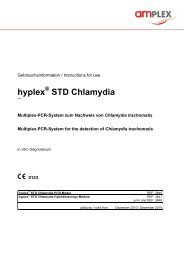hyplex SuperBug ID
hyplex SuperBug ID
hyplex SuperBug ID
Create successful ePaper yourself
Turn your PDF publications into a flip-book with our unique Google optimized e-Paper software.
5.3 Additional reagents and accessories required<br />
Reagents<br />
UltraStart Tth - DNA polymerase incl. reaction buffer (Cat. No. 3955)<br />
sterile, double-distilled H 2 O<br />
<strong>hyplex</strong> ® lysis buffer (Cat. No. 3950)<br />
Accessories<br />
Heating block<br />
PCR thermocycler<br />
PCR reaction vessels (recommended: 0.2 ml)<br />
Pipettes with sterile disposable tips<br />
Incubator (50° C ± 1° C)<br />
Microtiter plate photometer for measuring extinction at 450 nm and 620 nm<br />
6. Warnings and precautions<br />
All reagents and materials which come into contact with potentially infectious<br />
samples must be treated with suitable disinfectant or autoclaved.<br />
Suitable disposable gloves must be worn during the entire test.<br />
The conjugate, the TMB substrate solution and the washing buffer contain<br />
preservatives. Avoid contact with the skin or mucous membranes. If this does<br />
happen, rinse affected areas with plenty of water.<br />
Phosphoric acid is an irritating substance. Avoid contact with the skin and mucous<br />
membranes. If this does happen, rinse affected areas with plenty of water.<br />
7. Handling notes<br />
With the exception of the positive control probes (2...8° C), the reagents of the <strong>hyplex</strong> ®<br />
<strong>SuperBug</strong> <strong>ID</strong> PCR modules should be stored at - 20° C after receiving them. Avoid<br />
frequent thawing and freezing of the reagents. After using for the first time, the reagents<br />
may be stored at 2...8° C to avoid thawing and freezing steps but in this case the<br />
reagents should be used within three months.<br />
The reagents of the <strong>hyplex</strong> ® <strong>SuperBug</strong> <strong>ID</strong> hybridisation modules should be stored at<br />
2...8° C.<br />
Before beginning the test, the washing buffer, TMB substrate solution, the stop solution<br />
as well as the closed snap-seal bag with the microtitre wells should be kept at room<br />
temperature (18...25° C) for at least 30 minutes. The stringent washing solution must be<br />
preheated to 50° C. Always keep the hybridisation buffer and the conjugate cool.<br />
The kits have an expiry date. Quality cannot be guaranteed after this date.<br />
To minimize the probability of nonspecific product formation, it is recommended that the<br />
amplification reactions be pipetted on ice and that DNA polymerase be the last reagent<br />
to be added. Due to the danger of contamination, suitable (non-powdered) disposable<br />
gloves and pipette tips with filter insert should be used when preparing for the test.<br />
26




